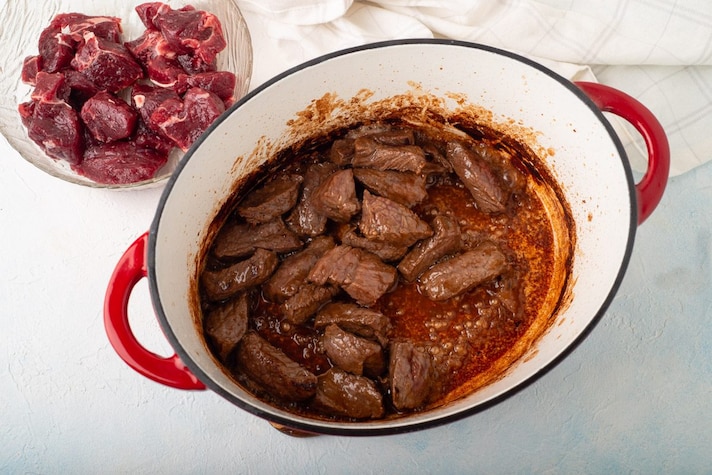Can You Really Taste the Difference Between Grass-Fed and Grain-Fed Beef?
Grass-fed and grain-fed beef offer distinct differences in flavor, texture, and nutrition. Grass-fed beef tends to have a stronger, more complex flavor and is leaner, with higher omega-3s and CLA. Grain-fed beef is milder, more tender, and higher in fat. The choice depends on personal preference, health goals, and environmental considerations.
;Resize,width=742;)
When shopping for beef, you’ve likely seen labels touting "grass-fed" and "grain-fed" options. These terms often spark debates about taste, health benefits, and ethical considerations, but when it comes to flavor, can you really tell the difference between grass-fed and grain-fed beef? Let’s take a closer look at these two types of beef, comparing their taste, texture, nutritional content, and environmental impact.
The Basics: Grass-Fed vs. Grain-Fed Beef
Grass-Fed Beef:
Grass-fed beef comes from cattle that are raised primarily on a diet of grass, forage, and hay. These animals are typically allowed to roam and graze in open pastures, a more natural and sustainable method of raising cattle. Grass-fed beef is often considered a healthier option because the cows’ diet is closer to what they would naturally eat in the wild.
Grass-fed beef is also leaner than grain-fed beef, with less fat and a slightly firmer texture. The flavor tends to be more complex, with a stronger, more distinct beef taste that some describe as “earthy” or “grassy.”
Grain-Fed Beef:
Grain-fed beef, also known as grain-finished beef, comes from cattle that are fed a diet of grains such as corn and soy for the final months of their life. This method of feeding is designed to fatten the cows quickly, leading to marbled meat with more fat and a tender, juicy texture.
Grain-fed beef is often milder in flavor, with a slightly sweeter taste due to the grains in the animals’ diet. The higher fat content makes it more tender and provides a rich, buttery texture that many beef lovers enjoy.

Flavor: Can You Really Taste the Difference?
The flavor differences between grass-fed and grain-fed beef are noticeable but subtle, and much of it comes down to personal preference.
Grass-Fed Beef:
Grass-fed beef has a bolder, more robust flavor. The diet of grass and forage gives it a distinctive taste that many describe as “earthy” or even “grassy.” It can also be slightly gamey, especially in older cows, but this adds to its complexity. The leaner nature of grass-fed beef means that the flavor is more concentrated and can stand out more on its own.
Some people may find the taste of grass-fed beef to be stronger and less familiar than the mild flavor of grain-fed beef, while others prefer it for its richness and more natural taste. It’s often described as having a “truer” beef flavor.
Grain-Fed Beef:
Grain-fed beef tends to be more tender due to its higher fat content, which also contributes to a milder, slightly sweeter flavor. The grains in the cattle’s diet affect the fat profile, resulting in a more marbled cut of meat with a buttery texture. This can make grain-fed beef more palatable to those who prefer a more tender, less gamey flavor.
The flavor is often described as more familiar or mainstream, making it a popular choice for consumers accustomed to the taste of beef commonly found in grocery stores or restaurants. The marbling in grain-fed beef contributes to its richness and juiciness, which many people associate with high-quality beef.

Nutritional Comparison
Grass-Fed Beef:
Grass-fed beef is generally considered to be the healthier option due to its leaner profile. It tends to have fewer calories and less fat than grain-fed beef. Additionally, grass-fed beef is higher in omega-3 fatty acids, which are beneficial for heart health, and contains more conjugated linoleic acid (CLA), which has been linked to fat loss and improved metabolic health.
Grass-fed beef also tends to have higher levels of vitamins A and E, both of which are antioxidants that support immune function and skin health.
Grain-Fed Beef:
Grain-fed beef is higher in fat and calories, which can make it more indulgent and satisfying to some people. The fat in grain-fed beef is predominantly monounsaturated and saturated fats, which have been associated with higher cholesterol levels when consumed in excess.
While grain-fed beef doesn’t have as many of the same heart-healthy omega-3 fatty acids as grass-fed beef, it is still a good source of protein, iron, and B vitamins, making it a nutritious choice for many people.

Ethical and Environmental Considerations
Grass-Fed Beef:
Grass-fed beef is often considered more sustainable and humane compared to grain-fed beef. Grass-fed cattle are typically raised in more natural conditions, with access to pasture and a diet that closely resembles what they would eat in the wild. This method of farming is also less resource-intensive, requiring less grain, water, and feed than grain-fed cattle.
However, grass-fed beef requires more land and can take longer to raise the animals to slaughter weight, which can increase the environmental impact in some cases. Additionally, not all grass-fed operations are certified organic or pasture-based, so it’s important to look for sustainable certifications.
Grain-Fed Beef:
Grain-fed beef production is associated with higher greenhouse gas emissions and more intensive land and resource use. The feedlot system used for grain-fed cattle is resource-heavy, relying on large amounts of corn, soy, and water to fatten the animals quickly.
While grain-fed beef is more widely available and affordable, it has a greater environmental footprint due to the large-scale farming methods and the energy required for transportation and feed production.

The Verdict: Which is Better for You?
When it comes to taste, the choice between grass-fed and grain-fed beef is largely a matter of personal preference. If you prefer a leaner, more flavorful cut of beef with a distinct taste, grass-fed beef may be your go-to. It’s also the better option if you’re looking for a healthier, more sustainable choice.
On the other hand, if you prefer a tender, juicy, and milder flavor with a familiar taste, grain-fed beef is the way to go. It’s often more affordable and widely available, making it an easy choice for many consumers.
Ultimately, both grass-fed and grain-fed beef have their merits, and the decision comes down to your priorities, whether it’s taste, nutrition, sustainability, or budget. Whichever you choose, understanding the differences can help you make an informed decision that aligns with your values and preferences.
;Resize,width=767;)

;Resize,width=712;)
;Resize,width=712;)
